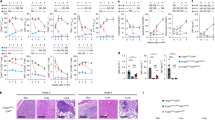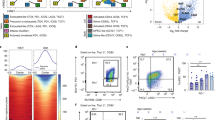Abstract
Regulatory T cells (Treg cells) are central to the maintenance of immune homeostasis. However, little is known about the stability of Treg cells in vivo. In this study, we demonstrate that a substantial percentage of cells had transient or unstable expression of the transcription factor Foxp3. These 'exFoxp3' T cells had an activated-memory T cell phenotype and produced inflammatory cytokines. Moreover, exFoxp3 cell numbers were higher in inflamed tissues in autoimmune conditions. Adoptive transfer of autoreactive exFoxp3 cells led to the rapid onset of diabetes. Finally, analysis of the T cell receptor repertoire suggested that exFoxp3 cells developed from both natural and adaptive Treg cells. Thus, the generation of potentially autoreactive effector T cells as a consequence of Foxp3 instability has important implications for understanding autoimmune disease pathogenesis.
This is a preview of subscription content, access via your institution
Access options
Subscribe to this journal
Receive 12 print issues and online access
$209.00 per year
only $17.42 per issue
Buy this article
- Purchase on Springer Link
- Instant access to full article PDF
Prices may be subject to local taxes which are calculated during checkout







Similar content being viewed by others
References
Tang, Q. et al. Central role of defective interleukin-2 production in the triggering of islet autoimmune destruction. Immunity 28, 687–697 (2008).
Bluestone, J.A., Tang, Q. & Sedwick, C.E. T regulatory cells in autoimmune diabetes: past challenges, future prospects. J. Clin. Immunol. 28, 677–684 (2008).
Wan, Y.Y. & Flavell, R.A. Regulatory T-cell functions are subverted and converted owing to attenuated Foxp3 expression. Nature 445, 766–770 (2007).
Hori, S., Nomura, T. & Sakaguchi, S. Control of regulatory T cell development by the transcription factor Foxp3. Science 299, 1057–1061 (2003).
Bennett, C.L. & Ochs, H.D. IPEX is a unique X-linked syndrome characterized by immune dysfunction, polyendocrinopathy, enteropathy, and a variety of autoimmune phenomena. Curr. Opin. Pediatr. 13, 533–538 (2001).
Bennett, C.L. et al. The immune dysregulation, polyendocrinopathy, enteropathy, X-linked syndrome (IPEX) is caused by mutations of FOXP3. Nat. Genet. 27, 20–21 (2001).
Brunkow, M.E. et al. Disruption of a new forkhead/winged-helix protein, scurfin, results in the fatal lymphoproliferative disorder of the scurfy mouse. Nat. Genet. 27, 68–73 (2001).
Bluestone, J.A. & Abbas, A.K. Natural versus adaptive regulatory T cells. Nat. Rev. Immunol. 3, 253–257 (2003).
Gavin, M.A. et al. Foxp3-dependent programme of regulatory T-cell differentiation. Nature 445, 771–775 (2007).
Williams, L.M. & Rudensky, A.Y. Maintenance of the Foxp3-dependent developmental program in mature regulatory T cells requires continued expression of Foxp3. Nat. Immunol. 8, 277–284 (2007).
Yang, X.O. et al. Molecular antagonism and plasticity of regulatory and inflammatory T cell programs. Immunity 29, 44–56 (2008).
Zhou, X. et al. Selective miRNA disruption in T reg cells leads to uncontrolled autoimmunity. J. Exp. Med. 205, 1983–1991 (2008).
Komatsu, N. et al. Heterogeneity of natural Foxp3+ T cells: a committed regulatory T-cell lineage and an uncommitted minor population retaining plasticity. Proc. Natl. Acad. Sci. USA 106, 1903–1908 (2009).
Tsuji, M. et al. Preferential generation of follicular B helper T cells from Foxp3+ T cells in gut Peyer's patches. Science 323, 1488–1492 (2009).
Srinivas, S. et al. Cre reporter strains produced by targeted insertion of EYFP and ECFP into the ROSA26 locus. BMC Dev. Biol. 1, 4 (2001).
Fontenot, J.D. et al. Regulatory T cell lineage specification by the forkhead transcription factor foxp3. Immunity 22, 329–341 (2005).
Kishimoto, H. & Sprent, J. The thymus and negative selection. Immunol. Res. 21, 315–323 (2000).
Jordan, M.S. et al. Thymic selection of CD4+CD25+ regulatory T cells induced by an agonist self-peptide. Nat. Immunol. 2, 301–306 (2001).
Huehn, J., Polansky, J.K. & Hamann, A. Epigenetic control of FOXP3 expression: the key to a stable regulatory T-cell lineage? Nat. Rev. Immunol. 9, 83–89 (2009).
Floess, S. et al. Epigenetic control of the foxp3 locus in regulatory T cells. PLoS Biol. 5, e38 (2007).
Kim, H.P. & Leonard, W.J. CREB/ATF-dependent T cell receptor-induced FoxP3 gene expression: a role for DNA methylation. J. Exp. Med. 204, 1543–1551 (2007).
Polansky, J.K. et al. DNA methylation controls Foxp3 gene expression. Eur. J. Immunol. 38, 1654–1663 (2008).
Zhou, L. et al. TGF-β-induced Foxp3 inhibits TH17 cell differentiation by antagonizing RORγt function. Nature 453, 236–240 (2008).
Katz, J.D., Wang, B., Haskins, K., Benoist, C. & Mathis, D. Following a diabetogenic T cell from genesis through pathogenesis. Cell 74, 1089–1100 (1993).
Tang, Q. et al. In vitro-expanded antigen-specific regulatory T cells suppress autoimmune diabetes. J. Exp. Med. 199, 1455–1465 (2004).
Wong, J., Mathis, D. & Benoist, C. TCR-based lineage tracing: no evidence for conversion of conventional into regulatory T cells in response to a natural self-antigen in pancreatic islets. J. Exp. Med. 204, 2039–2045 (2007).
Tang, Q. & Bluestone, J.A. The Foxp3+ regulatory T cell: a jack of all trades, master of regulation. Nat. Immunol. 9, 239–244 (2008).
Salomon, B. et al. B7/CD28 costimulation is essential for the homeostasis of the CD4+CD25+ immunoregulatory T cells that control autoimmune diabetes. Immunity 12, 431–440 (2000).
Sakaguchi, S. et al. Foxp3+CD25+CD4+ natural regulatory T cells in dominant self-tolerance and autoimmune disease. Immunol. Rev. 212, 8–27 (2006).
Hsieh, C.S., Zheng, Y., Liang, Y., Fontenot, J.D. & Rudensky, A.Y. An intersection between the self-reactive regulatory and nonregulatory T cell receptor repertoires. Nat. Immunol. 7, 401–410 (2006).
Hsieh, C.S. & Rudensky, A.Y. The role of TCR specificity in naturally arising CD25+CD4+ regulatory T cell biology. Curr. Top. Microbiol. Immunol. 293, 25–42 (2005).
Liu, W. et al. CD127 expression inversely correlates with FoxP3 and suppressive function of human CD4+ T reg cells. J. Exp. Med. 203, 1701–1711 (2006).
Lu, L.F. et al. Foxp3-dependent microRNA155 confers competitive fitness to regulatory T cells by targeting SOCS1 protein. Immunity 30, 80–91 (2009).
Lochner, M. et al. In vivo equilibrium of proinflammatory IL-17+ and regulatory IL-10+Foxp3+RORγt+ T cells. J. Exp. Med. 205, 1381–1393 (2008).
Lal, G. et al. Epigenetic regulation of Foxp3 expression in regulatory T cells by DNA methylation. J. Immunol. 182, 259–273 (2009).
Zheng, Y. et al. Regulatory T-cell suppressor program co-opts transcription factor IRF4 to control TH2 responses. Nature 458, 351–356 (2009).
Koch, M.A. et al. The transcription factor T-bet controls regulatory T cell homeostasis and function during type 1 inflammation. Nat. Immunol. 10, 595–602 (2009).
Cobb, B.S. et al. A role for Dicer in immune regulation. J. Exp. Med. 203, 2519–2527 (2006).
Rose, N.R. The adjuvant effect in infection and autoimmunity. Clin. Rev. Allergy Immunol. 34, 279–282 (2008).
Acknowledgements
We thank C.J. McArthur, M. Lee, N. Grewal, S. Jiang, J. Beilke and S. Zhu for technical assistance; N. Martinier and D. Fuentes for animal husbandry; and A. Abbas, Q. Tang, M. Anderson, R. Locksley and members of the Bluestone laboratory for discussions and reading the manuscript. Supported by the US National Institutes of Health (P01 AI35297 and U19 AI056388 to J.A.B., and P30 DK63720 for core support), the American Diabetes Association (X.Z.), the Swiss National Science Foundation (PBBSB-118644 to L.T.J.), the Roche Research Foundation (L.T.J.), the Novartis Foundation (formerly Ciba-Geigy Jubilee Foundation; L.T.J.) and the US National Institute of General Medical Sciences (1 R25 GM56847 to C.P.).
Author information
Authors and Affiliations
Contributions
X.Z. and J.A.B. initiated the study; X.Z., S.L.B.-B. and L.T.J. designed and did experiments, analyzed data and wrote the manuscript; C.P. and M.M.-L. designed and did experiments; M.A. did bioinformatic analysis of TCR sequences with help from X.Z., S.L.B.-B. and M.N.; M.N. and W.R. did experiments; and J.A.B. designed experiments, supervised the work, analyzed data and wrote the manuscript.
Corresponding author
Supplementary information
Supplementary Text and Figures
Supplementary Figures 1–3 and Supplementary Tables 1–2 (PDF 1925 kb)
Rights and permissions
About this article
Cite this article
Zhou, X., Bailey-Bucktrout, S., Jeker, L. et al. Instability of the transcription factor Foxp3 leads to the generation of pathogenic memory T cells in vivo. Nat Immunol 10, 1000–1007 (2009). https://doi.org/10.1038/ni.1774
Received:
Accepted:
Published:
Issue Date:
DOI: https://doi.org/10.1038/ni.1774
This article is cited by
-
Anti-human-TIGIT agonistic antibody ameliorates autoimmune diseases by inhibiting Tfh and Tph cells and enhancing Treg cells
Communications Biology (2023)
-
Deletion of PD-1 destabilizes the lineage identity and metabolic fitness of tumor-infiltrating regulatory T cells
Nature Immunology (2023)
-
Regulatory T cells in psoriatic arthritis: an IL-17A-producing, Foxp3intCD161 + RORγt + ICOS + phenotype, that associates with the presence of ADAMTSL5 autoantibodies
Scientific Reports (2022)
-
Retinoic acid signaling acts as a rheostat to balance Treg function
Cellular & Molecular Immunology (2022)
-
IL-4 inhibits regulatory T cells differentiation by HDAC9-mediated epigenetic regulation
Cell Death & Disease (2021)



